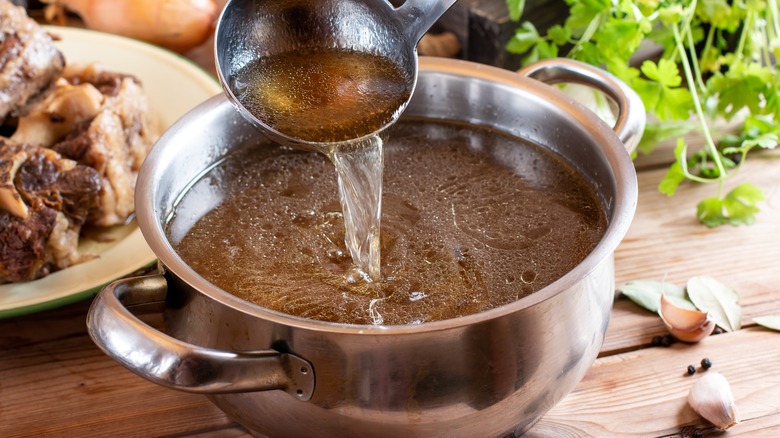The Simple Tip For Making Sure You Buy The Best Beef Broth
If there's no time or ingredients on hand to make beef broth at home, store-bought is a quick and convenient option. When perusing the grocery store aisle, knowing what to look for on labels is key to making a quality selection. In the case of beef broth — this may seem obvious — the list of ingredients should include beef. Shockingly enough, some broth brands are lacking real beef, which means they're also lacking flavor, and ultimately, quality.
The best brands have beef stock listed as the first ingredient, along with natural ingredients, like a mirepoix consisting of onions, celery, and carrots. Along with making certain that beef is on the label, seeing a simple and short ingredient list usually indicates that a brand is free of added chemicals and artificial flavors, which can adversely affect quality. Along with checking your stock ingredients, you should also know the key differences between beef stock, broth, and bone broth, as they are not used interchangeably.
What's the difference between broth and stock?
While broth and stock are often considered the same, there are a few important differences between them. Broth results from simmering meat (in this case, beef) on low heat over a long period to infuse it with tasty flavor. Because broth typically doesn't include too many other ingredients, salt is needed to boost the inherent flavor of the finished product. However, you can usually find low-sodium brands of beef broth on grocery store shelves if you're watching your salt intake. Stock is made using the same process, only with bones instead of meat, plus vegetables, herbs, and aromatics. It has a richer flavor, is high in protein, and is lower in sodium so there is room for seasoning when used in recipes.
There's also bone broth, which is made from meat, bones, and connective tissue. The process of creating bone broth is much longer than a standard broth or stock. The ingredients may need to be simmered for many hours, or even days, to ensure they fully break down. On the other hand, stocks and conventional broths usually only require a cooking time of 3 to 4 hours.
Using beef broth and storing leftovers
There are many ways to use beef broth in your cooking beyond soups and stews. It can be used in shepherd's pie, chili, cheesesteaks, beef and noodle dishes, and much more. Using beef broth to make baked meatballs is a great idea, as the broth can majorly boost the flavor and texture of the finished dish.
When it comes to storing leftover food made with beef broth, the right approach helps maintain quality and flavor. Once cooled, you can transfer the leftovers to a container with an airtight seal. Next, relocate the container to your refrigerator or freezer. According to the FDA, soups and stews that contain meat can be kept in the refrigerator for three to four days, and in the freezer for about two to three months. Always label the food going in the freezer so you know when to use it. When using the correct storage methods, you'll get to enjoy meals you pull from the freezer on a busy weeknight, all made with high-quality store-bought beef broth.


